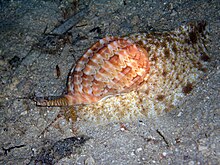Harpa
| Harpa | |
|---|---|
 |
|
| A live individual of Harpa major | |
| Scientific classification | |
| Kingdom: | Animalia |
| Phylum: | Mollusca |
| Class: | Gastropoda |
| (unranked): | clade Caenogastropoda clade Hypsogastropoda clade Neogastropoda |
| Superfamily: | Muricoidea |
| Family: | Harpidae |
| Subfamily: | Harpinae |
| Genus: |
Harpa Röding, 1798 |
| Type species | |
|
Buccinum harpa Linnaeus, 1758 |
|
| Synonyms | |
|
Harpalis Link, 1807 |
|
Harpalis Link, 1807
Harpa, common name the "harp snails", is a genus of large predatory sea snails, marine gastropod mollusks in the family Harpidae.
Harpa is the type genus of the family Harpidae.
The shell has an ovate-oblong shape. It is more or less inflated, generally pretty thin, enamelled, and provided with parallel, longitudinal, inclined and acute ribs. ; The body whorl is much larger than all the others together. The spire is slightly elevated. The aperture is large, oval, dilated, strongly emarginated inferiorly, and without siphonal canal. The outer lip is bordered by the last rib. The columella is smooth, simple, nearly straight and pointed at the base.
The animal has a flattened head, which supports a pair of pretty long, thick, and conical tentacles, with a small protuberance at their base, internally, where the eyes are situated. the mouth is simple, surrounded by a muscular margin, and furnished with a small, slender and pointed trunk. The organ of excitement is elongated, cylindrical, situated on the right side. The locomotive organ is very large, very broad at the anterior part, which is ear-shaped, and distinguished by a deep emargination upon each side. The posterior extremity is caducous, and destitute of an operculum.
The fleshy part of this mollusk is very strong, and very large. Its foot is enormous, thick, and extended considerably out of the shell. It cannot be wholly contained within the aperture, before which, by contracting itself, it forms a margin.
The foot is as if divided into two portions. The anterior broader, arcuated, ear-shaped, with a marginal furrow, and joined to the posterior part by a kind of neck. This latter, more extended, is somewhat oval, pointed, and slightly inflated above, without any appearance of operculum. When the animal is violently disturbed, it breaks off the posterior extremity of its foot, in order to withdraw itself more completely within its shell. In consequence of this an operculum would be useless to it, for it would be liable to be carried away by the rupture of the foot. Therefore, it is not possessed.
...
Wikipedia
